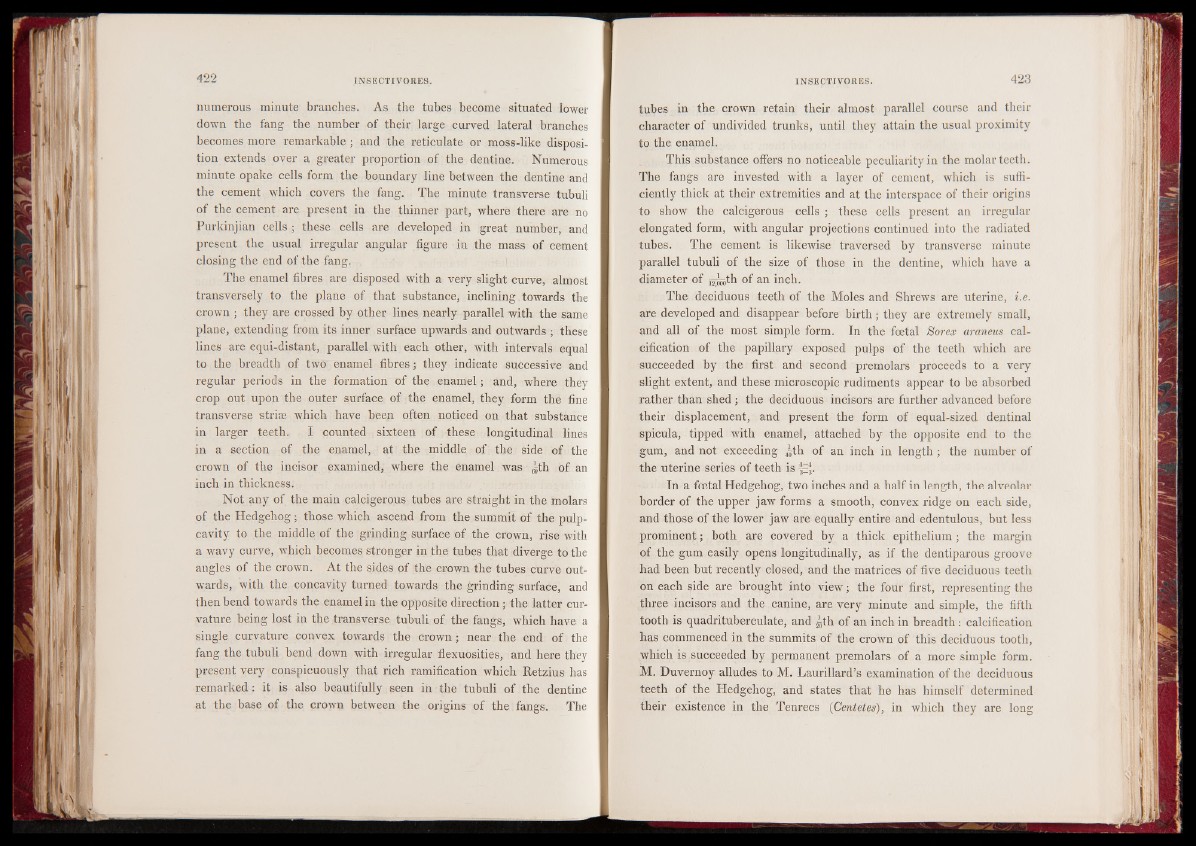
numerous minute branches. As the tubes become situated lower
down the fang the number of their large curved lateral branches
becomes more remarkable ; and the reticulate or moss-like disposition
extends over a greater proportion of the dentine. Numerous
minute opake cells form the boundary line between the dentine and
the cement which covers the fang. The minute transverse tubuli
of the cement are present in the thinner part, where there are no
Purkinjian cells ; these cells are developed in great number, and
present the usual irregular angular figure in the mass of cement
closing the end of the fang.
The enamel fibres are disposed with a very slight curve, almost
transversely to the plane of that substance, inclining towards the
crown ; they are crossed by other lines nearly parallel with the same
plane, extending from its inner surface upwards and outwards ; these
lines are equi-distant, parallel with each other, with intervals equal
to the breadth of two enamel fibres ; they indicate successive and
regular periods in the formation of the enamel ; and, where they
crop out upon the outer surface of the enamel, they form the fine
transverse striæ which have been often noticed on that substance
in larger teeth. I counted sixteen of these longitudinal lines
in a section of the enamel, at the middle of; the side of the
crown of the incisor examined, where the enamel was ^th of an
inch in thickness.
Not any of the main calcigerous tubes are straight in the molars
of the Hedgehog ; those which ascend from the summit of the pulp-
cavity to the middle of the grinding surface of the crown, rise with
a wavy curve, which becomes stronger in the tubes that diverge to the
angles of the crown. At the sides of the crown the tubes curve outwards,
with the concavity turned towards the grinding surface, and
then bend towards the enamel in the opposite direction ; the latter curvature
being lost in the transverse tubuli of the fangs, which have a
single curvature convex towards the crown ; near the end of the
fang the tubuli bend down with irregular flexuosities, and here they
present very conspicuously that rich ramification which Retzius has
remarked : it is also beautifully seen in the tubuli of the dentine
at the base of the crown between the origins of the fangs. The
tubes in the crown retain their almost parallel course and their
character of undivided trunks, until they attain the usual proximity
to the enamel.
This substance offers no noticeable peculiarity in the molar teeth.
The fangs are invested with a layer of cement, which is sufficiently
thick at their extremities and at the interspace of their origins
to show the calcigerous cells ; these cells present an irregular
elongated form, with angular projections continued iuto the radiated
tubes. The cement is likewise traversed by transverse minute
parallel tubuli of the size of those in the dentine, which have a
diameter of g^th of an inch.
The deciduous teeth of the Moles and Shrews are uterine, i.e.
are developed and disappear before birth ; they are extremely small,
and all of the most simple form. In the foetal Sorex araneus calcification
of the papillary exposed pulps of the teeth which are
succeeded by the first and second premolars proceeds to a very
slight extent, and these microscopic rudiments appear to be absorbed
rather than shed ; the deciduous incisors are further advanced before
their displacement, and present the form of equal-sized dentinal
spicula, tipped with enamel, attached by the opposite end to the
gum, and not exceeding ^-th of an inch in length ; the number of
the uterine series of teeth is fE^.
In a foetal Hedgehog, two inches and a half in length, the alveolar
border of the upper jaw forms a smooth, convex ridge on each side,
and those of the lower jaw are equally entire and edentulous, but less
prominent ; both are covered by a thick epithelium ; the margin
of the gum easily opens longitudinally, as if the dentiparous groove
had been but recently closed, and the matrices of five deciduous teeth
on each side are brought into view ; the four first, representing the
three incisors and the canine, are very minute and simple, the fifth
tooth is quadrituberculate, and ^th of an inch in breadth : calcification
has commenced in the summits of the crown of this deciduous tooth,
which is succeeded by permanent premolars of a more simple form.
M. Duvernoy alludes to M. Laurillard’s examination of the deciduous
teeth of the Hedgehog, and states that he has himself determined
their existence in the Tenrecs (Cent et es), in which they are long